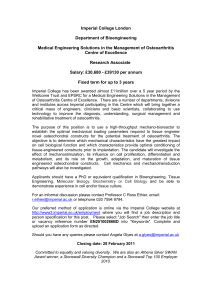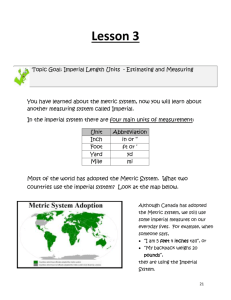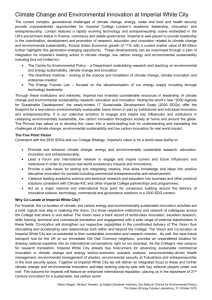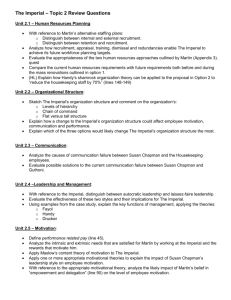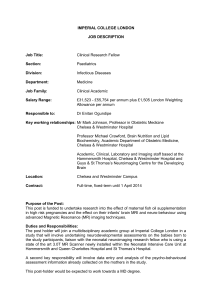SI and Imperial Conversions
advertisement
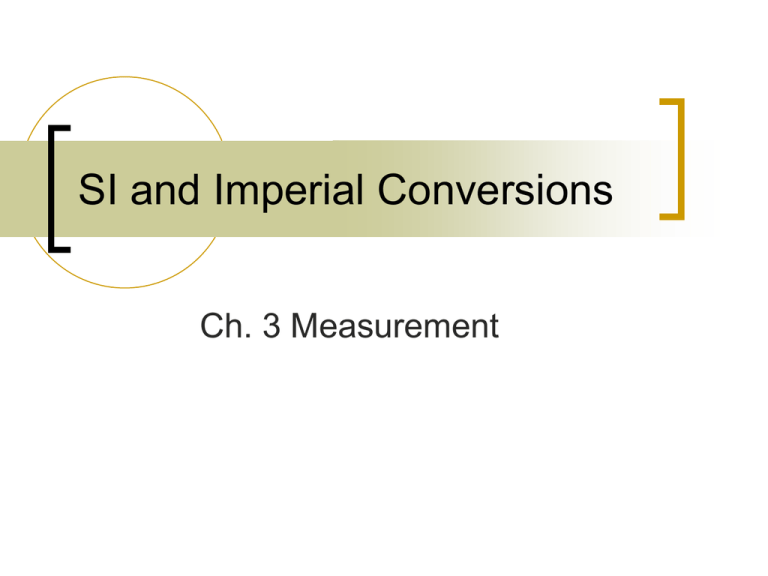
SI and Imperial Conversions Ch. 3 Measurement SI and Imperial Conversions Sometimes we may need to convert from SI units to Imperial, or from Imperial to SI units. To do this, we will require a chart that describes the basic conversion factors: Conversion Chart Conversion Factors Length Imperial SI Capacity/ Volume SI Imperial Imperial SI 1 gal = 4.546 L SI Imperial 1 in = 2.54 cm 1 cm = 0.394 in 1 L = 0.22 gal 1 ft = 0.305 m 1 m = 3.281 ft 1 yd = 0.914 m 1 m = 1.094 yd Imperial SI SI Imperial 1 mi = 1.609 km 1 km = 0.621 mi 1 oz = 28.35 g 1 g = 0.0305 oz 1 lb = 0.454 kg 1 kg = 2.205 lb 1 lb = 454 g 1 g = 0.002 lb Mass/Weight *note: These conversions are approximate. oz = ounce, lb = pound, gal = gallon To convert between units, we will use proportions: W ANT 1) Set up a fraction : H A V E Place an “x” and the units for what you WANT. 2) Find the appropriate conversion on the chart. 3) Set up a second fraction, with the units of what you WANT in the numerator and what you HAVE in the denominator 4) Cross multiply and divide to get the correct answer. Ex1. Carlos measures 14 cm but he needs to know this length in inches. How many inches is 14 cm? 14cm = _______in ? 1) WANT inches HAVE centimeters x _ in 14 cm 2) we are converting from SI imperial, so we will use: 1 cm = 0.394 in Ex. 1 Continued 3) 0 .3 9 4 in 4) x _ in 1cm 14 cm 0.394 in 1cm 14 x 0.394 1 = 5.52 in *note: rounded to 2 decimal places* There are 5.52 in. in 14 cm. OR ~ 5 1 2 in. Ex2. You are on vacation in Hawaii and are going on a mountain hike. You read in the guide book that the hike is 3.5 miles. How many km is this? 1) WANT km HAVE mi x _ km 3.5 m i 2) we are converting Imperial SI so we will use: 1 mi = 1.609 km 1.609 km 3) 1m i 1.609 km x _ km 4) 3.5 m i = 1m i 3.5 x 1.609 1 = 5.63 km *note: rounded to 2 decimal places* There are 5.63 km in 3.5 miles. But what if…? We may need to complete more than one conversion if what we want is not on the conversion factor chart. For example, you may need to change from Imperial SI first , then convert the SI units to the desired unit. Ex3. Edmund is measuring wood planks to make a chair. He measures a piece to be 0.8 m, but he needs to know how many inches this will be. 1) We WANT inches we HAVE meters. BUT there is no conversion on the chart from meters to inches. We must first convert m ft then ft in. 2) SI Imperial so we will use: 1 m = 3.281 ft x _ feet 0 .8 m Ex. 3 Continued 3.281 feet 3) 4) x _ 1m feet 0 .8 m = 3.281 feet 0.8 x 3.281 1 = 2.62 ft 1m We must now convert from ftin 7 2.62 ft x 12 = 31.44 in OR ~3116 in We could have converted the SI units first (from m cm) and then converted from SIImperial. Let’s try it! 1) 0.8 m = ____cm? 0.8 x 100 = 80 cm KHDmdcm x _ in 80 cm 2) SI Imperial, so we will use: 1 cm = 0.394 in 3) 0 .3 9 4 in 1cm x _ in 4) 80 cm = 0 .3 9 4 in 1cm 31.52 in. OR ~31 80 x 0.394 1 = 1 2 in
